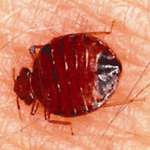Bed Bug Basics
It is critical that providers act quickly to quell any outbreaks and to be honest with their stakeholders while they are doing it.
Missy Henriksen
10/1/2012
In 2011, the National Pest Management Association and the University of Kentucky conducted a survey of U.S. pest professionals and found that bed bug encounters in settings outside single-family homes and apartments had increased significantly from the previous year.
Specifically, 46 percent of pest professionals treated bed bugs in nursing homes and assisted living communities in 2011, compared with 25 percent in 2010. In both settings, the issue of bed bug infestations can generate anxiety among residents, their families, and staff.
The foot traffic of daily visitors or employees and the moving in of personal belongings of tenants can all provide easy access for bed bugs to enter a facility. Because of their small size and need to be near humans, bed bugs can hitchhike in bags, shoes, luggage, and on clothing.
Unlike other facilities of similar sizes, such as college dorms or schools, these environments pose a greater challenge in terms of treatment of bed bugs because of the physical state of the residents and the importance of not disrupting the care that is provided.
Bed Bug Biology
Adult bed bugs resemble a flat apple seed, while hatchlings are so small they can pass through a stitch-hole in a mattress. These pests feed on human blood and are found wherever people are, often hiding in spots humans can’t see and only coming out to feed when an opportunity presents itself.

Bed bugs are especially problematic and challenging to treat because they are quite elusive and breed quickly. A female bed bug can lay one to five eggs in a day and more than 500 in a lifetime.
Their name is a bit of a misnomer, as bed bugs tend to hide not only in beds, but also in other areas such as behind headboards and baseboards and in upholstered furniture, suitcases, shoes, boxes, wallpaper, picture frames, electrical switch plates, and other small cracks and crevices close to humans.
Developing An Action Plan
In 2011, two nursing home employees in Ohio placed an anonymous call to a local television news station, informing a reporter that the nursing home had discovered a bed bug infestation. The nursing home, the callers reported, was not telling the families of residents about the infestation, and employees were being threatened with termination if they spoke up about the problem.
Once the news van showed up at the nursing home and the reporter began asking questions, family members learned about the bed bug problem, and the facility’s parent company issued a statement.
When the story appeared on the news, the facility was portrayed negatively. Despite taking all the right steps to deal with the infestation once it became public, it appeared as if the management had tried to keep the problem under wraps.
This is why a written “
bed bug action plan” is so important. It prepares management and staff to respond to a problem as it arises and to deal with it in a swift and effective manner.
Everyone from management, to nurses, to the custodial staff should be educated in basic bed bug biology and habits, especially their hitchhiking nature, which allows them to easily go from place to place.
Staff must know how to recognize bed bugs and their bites; the responsibility and roles regarding bed bugs, including the facility’s response and notification policy; and actions needed to reduce the risk of future infestations or incidents.
Preventing Future Infestations
Because of their size and elusive nature, as well as the conducive environment an assisted living community or nursing home provides, it can be difficult to prevent bed bug infestations from ever occurring again. However, education and vigilance on the part of management, staff, and family members can go a long way in minimizing or detecting the problems in time.
Following are some prevention tips:
- Develop a bed bug information sheet, including information on how to avoid bringing bed bugs into the facility.
- Consider encasing mattresses and box springs with bed bug-proof encasements.
- Establish a prohibition on used or secondhand furniture.
- Require that furniture, luggage, and other personal items be inspected by a professional (or a certified canine bed bug detection team), especially if there are recurring problems.
- Regularly vacuum or steam clean areas prone to bed bugs (under and around beds, upholstered furniture, luggage racks, and wall/floor junctions).
- Reduce clutter; seal cracks, crevices, and holes near beds; and repair or replace peeling wallpaper or paint.
- Follow good laundry-handling practices to prevent the dispersal of bed bugs, including keeping carts in the hallway during room service; separating the clean and dirty laundry on carts and in processing rooms; and keeping dirty laundry away from linen storerooms, linen closets, or any room that contains clean linens.
- If dirty laundry is transported to an outside cleaning facility, do not use the same vehicle for clean linens unless clean and dirty laundry can be completely isolated from each other.
Act Fast, Be Honest
Many assisted living communities and nursing homes may worry about their reputation and that residents may leave should they experience a bed bug infestation. However, the problem of bed bugs has become so pervasive that Americans have almost come to terms with the pest, just as they do with others that may invade their living spaces.
Nonetheless, it is imperative that long term care facilities deal with bed bugs quickly. Residents and their families will appreciate swift action and future precautions but may be less understanding of management if they’re not forthright, because that can often create even bigger problems.
Missy Henriksen is vice president of public affairs for the National Pest Management Association, a nonprofit organization committed to the protection of public health, food, and property. For more information about pests and prevention tips, visit www.PestWorld.org.